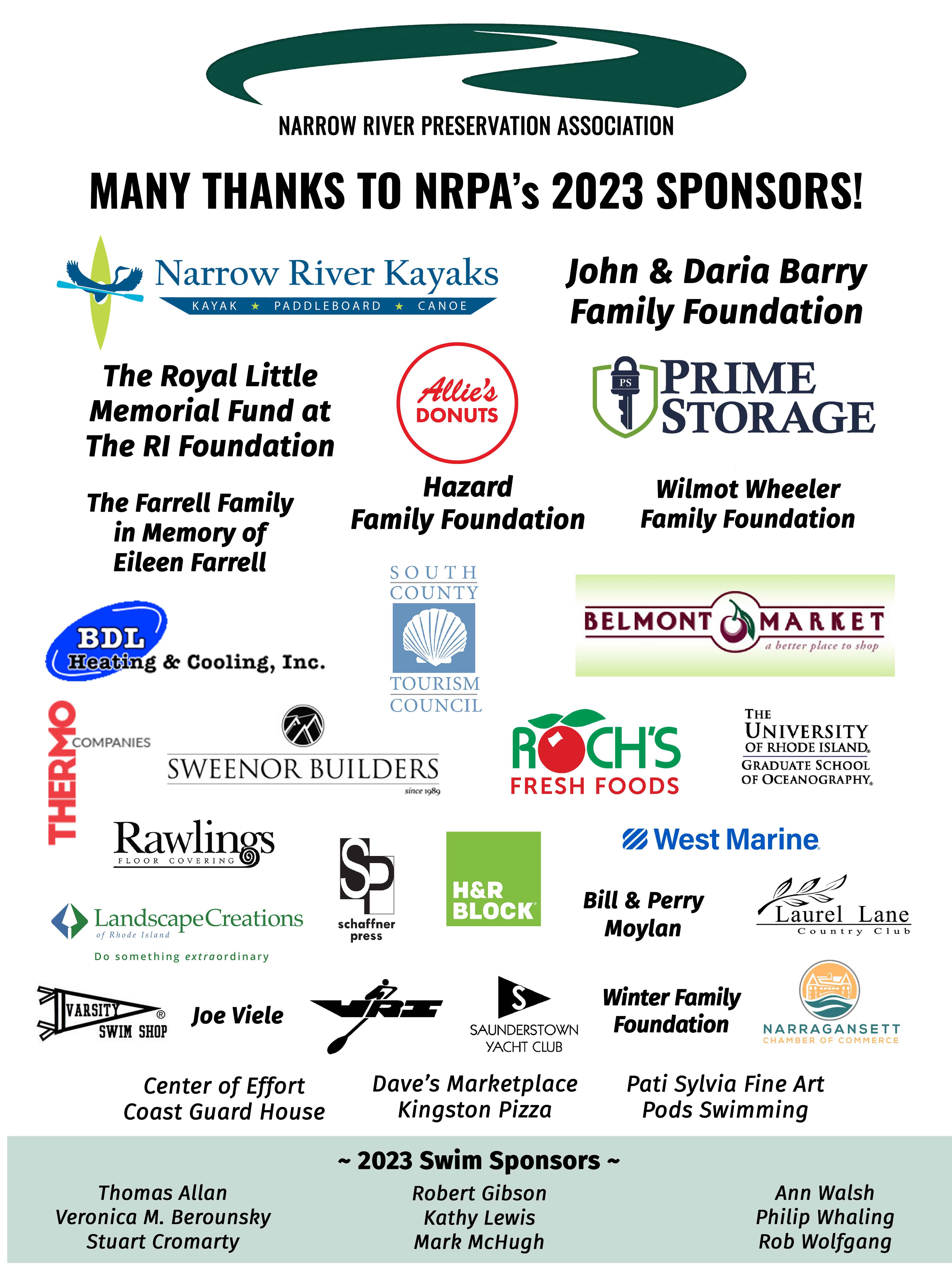The Willet (Tringa semipalmata)
By Craig Wood
The featured bird for the 2017 Narrow River Road Race T-shirt is the Willet (Tringa semipalmata). The Willet is one of our most conspicuous breeding species in the Narrow River estuary. They are large, stocky shorebirds (pigeon-sized body on long legs) with distinctive black-and-white wing markings. Willets have a thick, straight bill considerably longer than the head. Willet plumage is mottled brown during breeding and plain gray in winter. When startled, they take flight with a piercing “pill-will-willet” call that gives them their name. Willets are often seen alone. They walk deliberately, pausing to probe for crabs, worms and other prey in sand and mudflats, or to pick at insects and mollusks.
There are two nesting populations (subspecies) of Willet in North America; the Eastern Willet nests in salt marshes, barrier beaches, and mangroves along the Atlantic and Gulf Coasts from Newfoundland to northeastern Mexico. The Western Willet breeds in interior prairies from Alberta to Colorado. Eastern Willets winter in coastal eastern South America, whereas Western Willets winter on both coasts of North America south to Peru.
Interestingly, the Willet is a southern species that has extended its breeding range north in recent decades. Willets were first documented nesting in Rhode Island during 1987 and are now a locally common breeding species throughout the state. With an expanded breeding range, Willets are now also a common sight in Rhode Island during mitigation periods, especially during fall migration which occurs locally throughout July. Western Willets are sometimes observed in Rhode Island with flocks of Eastern Willets during fall migration.
Willets, along with the salt marsh sparrow (Ammodramus caudacutus), nest in the higher portions of salt marsh bordering Narrow River. This “high marsh” habitat has been disappearing in salt marshes throughout the region. This phenomenon is thought to be the result of accelerated sea level rise. Restoring high marsh is a major objective of the on-going dredging and marsh building project which is placing dredged material on the surface of the marsh to raise the elevation combating drowning and loss of habitat.
Cool Facts
- Although both parents incubate the eggs, only the male Willet spends the night on the nest.
- Willets and other shorebirds were once a popular food. By the early 1900s, Willets had almost vanished north of Virginia. The Migratory Bird Treaty Act of 1918 banned market hunting and marked the start of the Willet’s comeback to present numbers.
- Like Killdeer, Willets will pretend to be disabled by a broken wing in order to draw attention to themselves and lure predators away from their eggs or chicks.
- Because they find prey using the sensitive tips of their bills, and not just eyesight, Willets can feed both during the day and at night.
- Willet pairs often remain together for several years and return to the same nest sites.
Sources:
Rhode Island Wildlife Action Plan Species Profiles, Species of Greatest Conservation Need, accessed at http://www.dem.ri.gov/programs/bnatres/fishwild/swap/SGCNBirds.pdf.
All About Birds, The Cornel Lab of Ornithology, accessed at https://www.allaboutbirds.org/guide/Willet

Willet in Flight over Winnapaug Pond by David Uliss













 Rosalind Lucier, of South Kingstown High School, will be attending Wellesley College in Wellesley, MA in the fall, where she plans to study biochemistry. She has been a top performer in her SKHS classes and was ranked number 1 in her class. Rosalind was awarded Excellence in AP Biology and Excellence in AP Physics, as well as the Baush and Lomb Honorary Science Award. She is a recipient of the Girl Scout Gold Award. For her project, she created a children’s picture book, featuring Mark a talking quahog, who goes on adventures to educate the reader about the factors of climate change in Rhode Island.
Rosalind Lucier, of South Kingstown High School, will be attending Wellesley College in Wellesley, MA in the fall, where she plans to study biochemistry. She has been a top performer in her SKHS classes and was ranked number 1 in her class. Rosalind was awarded Excellence in AP Biology and Excellence in AP Physics, as well as the Baush and Lomb Honorary Science Award. She is a recipient of the Girl Scout Gold Award. For her project, she created a children’s picture book, featuring Mark a talking quahog, who goes on adventures to educate the reader about the factors of climate change in Rhode Island. Kate DeBoer is also a graduate of South Kingstown High School. Kate is planning on attending the University of Rhode Island, Kingston, RI. She has been accepted into the 6-year pharmacy program (PharmD). Kate was also a past NRPA Science Fair winner for her work studying water quality. She has organized beach clean-ups at the Narragansett Town Beach. Kate has also earned the prestigious Girl Scout Gold Award. Her project focused on encouraging children to eat healthier in order to improve their mental and physical health.
Kate DeBoer is also a graduate of South Kingstown High School. Kate is planning on attending the University of Rhode Island, Kingston, RI. She has been accepted into the 6-year pharmacy program (PharmD). Kate was also a past NRPA Science Fair winner for her work studying water quality. She has organized beach clean-ups at the Narragansett Town Beach. Kate has also earned the prestigious Girl Scout Gold Award. Her project focused on encouraging children to eat healthier in order to improve their mental and physical health. Wyndom Chace, graduated from North Kingstown with the highest ranking in her class and has chosen Williams College in Williamston, MA. She plans to pursue environmental science and chemistry. She was a member of the summer marine research team in the Biology Department at Salve Regina University. She has had an opportunity to present posters at two conferences detailing her work on sea level rise in North Kingstown and a second poster on changes in land use and vegetation in NK. She was a nominee for Save the Bay’s 2016 Walsh Award for Outstanding Environmental Advocacy. Wyndom is also quite an accomplished pianist.
Wyndom Chace, graduated from North Kingstown with the highest ranking in her class and has chosen Williams College in Williamston, MA. She plans to pursue environmental science and chemistry. She was a member of the summer marine research team in the Biology Department at Salve Regina University. She has had an opportunity to present posters at two conferences detailing her work on sea level rise in North Kingstown and a second poster on changes in land use and vegetation in NK. She was a nominee for Save the Bay’s 2016 Walsh Award for Outstanding Environmental Advocacy. Wyndom is also quite an accomplished pianist. Danielle Donadio, a graduate of Narragansett High School, plans to attend the University of New Hampshire in Durham, NH, where she is considering majoring in wildlife biology and conservation. Danielle is an honor student, a varsity athlete and a talented musician. She is a member of the RI Philharmonic Youth Wind Ensemble. In addition, Danielle is also a Level I Rehabilitator and volunteer at the Wildlife Rehabilitators Association of RI. She helps with feeding and rehabilitation of animals ranging from turtles to opossum and seagulls.
Danielle Donadio, a graduate of Narragansett High School, plans to attend the University of New Hampshire in Durham, NH, where she is considering majoring in wildlife biology and conservation. Danielle is an honor student, a varsity athlete and a talented musician. She is a member of the RI Philharmonic Youth Wind Ensemble. In addition, Danielle is also a Level I Rehabilitator and volunteer at the Wildlife Rehabilitators Association of RI. She helps with feeding and rehabilitation of animals ranging from turtles to opossum and seagulls.




